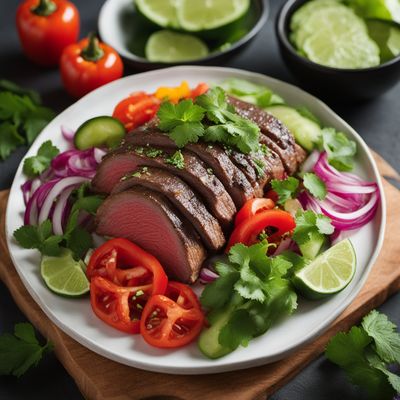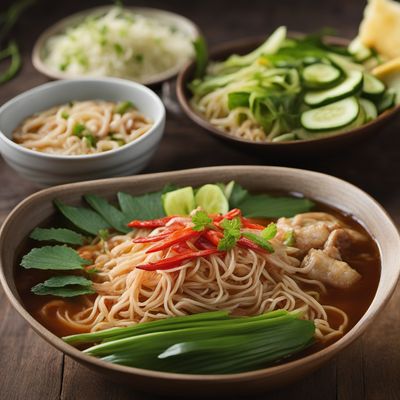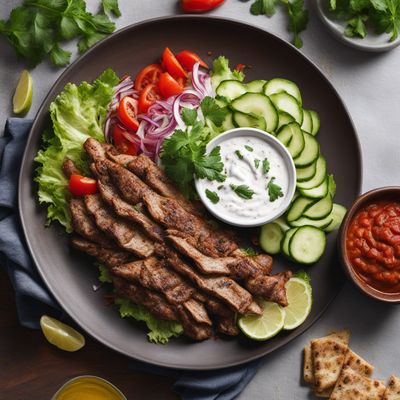
Ingredient
Armenian cucumbers
The Refreshing Elegance: Discovering Armenian Cucumbers
Armenian cucumbers are slender and elongated, reaching up to 2 feet in length. They have a thin, pale green skin that is tender and edible. The flesh is crisp and juicy, with a mild and slightly sweet taste. Unlike traditional cucumbers, Armenian cucumbers have minimal seeds, making them ideal for slicing, pickling, or adding to salads. They are often enjoyed raw, as their refreshing nature adds a cooling element to dishes.
Origins and history
Armenian cucumbers are believed to have originated in the Mediterranean region, particularly in Armenia and surrounding areas. They have been cultivated for centuries and are an integral part of Armenian cuisine. These cucumbers were introduced to other parts of the world through trade and migration, gaining popularity in various culinary traditions. Today, they are widely cultivated in different countries, including the United States, Mexico, and Israel. Armenian cucumbers are celebrated for their unique shape, taste, and versatility in both traditional and modern recipes.
Nutritional information
Armenian cucumbers are low in calories and rich in water content, making them a hydrating and refreshing choice. They are a good source of vitamins A and C, as well as dietary fiber. Incorporating Armenian cucumbers into your diet can contribute to overall hydration and provide essential nutrients.
Allergens
Individuals with cucumber allergies should avoid consuming Armenian cucumbers. Additionally, some people may experience digestive discomfort or bloating when consuming cucumbers in large quantities. It is important to listen to your body and consume cucumbers in moderation if you have any sensitivities or health conditions.
How to select
When selecting Armenian cucumbers, look for firm cucumbers that are free from blemishes or soft spots. The skin should be smooth and vibrant in color. Avoid cucumbers that are excessively large or have a yellowish hue, as they may be overripe. It is best to choose cucumbers that are smaller in size, as they tend to be more tender and have a milder flavor. If purchasing from a farmers market, ask the vendor about the freshness and origin of the cucumbers for the best quality.
Storage recommendations
To maintain the freshness and crispness of Armenian cucumbers, store them in the refrigerator. Place them in a perforated plastic bag or wrap them loosely in a paper towel to absorb excess moisture. Proper storage will help retain their texture and flavor for a longer period. Avoid storing cucumbers near ethylene-producing fruits, such as bananas or tomatoes, as they can accelerate the ripening process and affect the quality of the cucumbers.
How to produce
Armenian cucumbers can be easily grown in home gardens or containers. They thrive in warm climates and require well-drained soil and ample sunlight. Plant the seeds in spring or early summer, ensuring a spacing of about 12 inches between each plant. Regular watering and occasional fertilization will promote healthy growth. Harvest the cucumbers when they reach the desired size, typically around 12 to 18 inches in length. Enjoy them fresh or incorporate them into your favorite recipes.
Preparation tips
Armenian cucumbers can be enjoyed in various ways. They are often sliced and added to salads, providing a refreshing crunch. They can be pickled to create tangy and flavorful condiments. Armenian cucumbers can also be used as a substitute for traditional cucumbers in recipes, adding a unique twist to dishes. Try incorporating them into sandwiches, wraps, or chilled soups for a refreshing and light meal option.
Substitutions
Traditional cucumbers can be used as a substitute for Armenian cucumbers, although they may have a slightly different taste and texture. If you prefer a milder flavor, English cucumbers can be a suitable alternative. Additionally, zucchini or summer squash can be used as substitutes in certain recipes that call for sliced or grated cucumbers.
Culinary uses
Armenian cucumbers are commonly used in Armenian cuisine, where they are featured in salads, soups, and pickled preparations. They are also popular in Middle Eastern and Mediterranean cuisines, adding a refreshing element to mezze platters and side dishes. Armenian cucumbers can be found in various international grocery stores or specialty markets that cater to these culinary traditions.
Availability
Armenian cucumbers are commonly cultivated in countries such as Armenia, Turkey, Iran, and the United States. They are also grown in other regions with suitable climates, including parts of Europe, Asia, and North America. These cucumbers are often available in farmers markets or specialty grocery stores that focus on local or international produce.
More ingredients from this category
Recipes using Armenian cucumbers » Browse all

Grilled Pork Vermicelli Bowl with Chiapas Twist
Smoky Delights: Grilled Pork Vermicelli Bowl with a Chiapas Twist

West African Inspired Farmer's Salad
Savory Harvest Salad: A West African Twist on the Classic French Dish

Grilled Pork Satay with Peanut Sauce
Indonesian Delight: Grilled Pork Satay with Irresistible Peanut Sauce

Samoan Beef Salad
Tropical Beef Delight: A Samoan Twist on a Vietnamese Classic

Ivorian-inspired Fresh Vegetable Platter
Savory Delights: A Vibrant Ivorian Vegetable Feast

Peranakan-style Feiersténgszalot
Nyonya-inspired Luxembourger Salad

Assam Laksa with a Tangy Twist
Tantalizing Tamarind Assam Laksa

Muhajir-style Chicken Salad
Spiced Chicken Salad with a Muhajir Twist

Homemade Turkish Döner Kebab
Savor the Authentic Flavors of Homemade Turkish Döner Kebab

Classic French Countryside Salad
Rustic Delights: A Taste of the French Countryside

Spicy Armenian Delight
Fiery Flavors of Armenia: Spicy Armenian Delight

Ketoprak - Indonesian Peanut Salad
Indonesian Delight: Ketoprak - A Nutty Salad Sensation